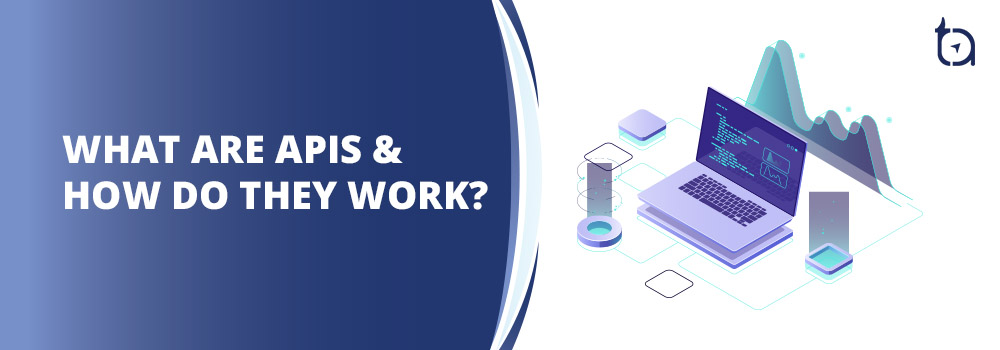What are APIs and How do they Work?

Author : John Prabhu 18th Nov 2020

If you’re using business software, you must have across terms such as API and webhooks. Today, let’s discuss what APIs are and how they work. Understanding the functionalities of API helps you to accomplish any task faster without compromising on efficiency.
API tools have significantly transformed how developers build apps. With APIs, developers have introduced a new vertical of Platform-as-a-Service (PaaS) companies. Only with the help of API-based tools can you implement integration between business software. Also, API integrations are nowadays critical to operations and revenue professionals.
An API is a set of rules that instructs how two machines should communicate among themselves. Some of the examples of API-based communication are cloud apps communicating with a server, two or more servers communicating among themselves, or apps communicating with an operating system. Simply put, whenever you’re using an app on your smartphone and/or computer or logging into a social network platform, you’re interacting with several different APIs behind the scenes. In this IT world, a majority of businesses use modern technology and at some level they need to retrieve data or interact with a database for which they will use APIs. The defined communication protocol feature of API makes it ideal for developers to build, connect, and integrate apps quickly and at scale.
Some businesses don’t rely only on internal APIs developed by their developers. Instead, they use external APIs as well through the developer community and launch products. Some of such examples include Twilio, Stripe, and Sendgrid, which serves the Platform-as-a-Service model. These types of companies allow developers to develop apps on their platform, which is capable of performing certain functions such as web server hosting, communication applications, etc. In recent times, businesses started delivering value by connecting different APIs and web services, which are termed as Integration Platform as a Service. IPaaS companies help in connecting different web services and tools to route data or automate workflows.
APIs play a crucial role in sculpting the modern business by implementing automation. But how do APIs work in the first place? Also, how can you use them to connect the third party services that you rely on to automate critical workflows?
How do APIs work? And how do they help you do more every day?
As said earlier, an API is nothing but a set of instructions that define how applications, computer or machine communicate among themselves. To compare it with, a desktop user accesses an application with the help of user interface; whereas, an application or computer interacts with another application or computer with the help of APIs.
Most web APIs act as a middleman between the application and the web server. The user initiates an API call that asks the application to do something; then the application will leverage an API to ask the web server to do some task. Here the API call is the request and the API itself is the middleman. Hence, every time you use an app to communicate with other apps or online systems, you’re seeking help from an API.
You must also note that web APIs are common but that doesn’t mean they are limited to web. There are APIs for every machine or system that allows interacting with other machines and systems.
How do APIs Work?
Let us discuss this topic with a normal day-to-day example. Suppose that you are entering a restaurant and you’re ready to order the dishes. The waiter in the restaurant acts as an intermediary between you and the kitchen. The waiter serves whatever you order from the restaurant’s menu without you having to communicate your order with any of the kitchen personnel. In software engineering, you are the customer, the waiter is the API, and the kitchen is the web server.
An API can also be an abstraction of the web server. The application (mobile app or website) will send an API call for a set of data to display for the user. The request (API call) is made through the API to access the web server and to retrieve the requested data. The retrieved data will then reflect on the user interface.
Here, the best part is the application doesn’t have to know how the web server works and its other functionalities. All it has to do is to send API calls to get the data it needs to display. Similarly, the end user doesn’t have to worry about how APIs will complete the tasks. All they need to do is to navigate the user interface and select the right option that would complete the desired task.
There is some key information in almost all of the API requests:
Type of request
Authorization credentials
Types of APIs
If you’ve heard about JSON (JavaScript Object Notation), you might have also heard about REST APIs. More than 70% of all public APIs use REST because it is reliable, fast, and can scale by reusing modular components without affecting the entire system.
REST API is a type of software design that permits access to web resources with the help of uniform and predefined set of operations. The data to be transferred (aka payload) defined in the request will itself be formatted in a language such as XML, JSON, or HTML. The set of operations are the methods available to HTTP, which allows the browsers to retrieve websites from web servers. These methods include GET, POST, PUT, DELETE, and others.
Also Read: Comprehensive Overview of REST APIs and How to Use Them?
There are four parts of a REST API request:
URI (uniform resource identifier, which is the URL address [aka endpoint])
HTTP method (commonly either GET or POST)
Headers (includes authentication tokens, defines the data format of the response, imposes rate limits, and performs other administrative tasks)
Body (the actual part of the request)
SOAP APIs: Simple Object Access Protocol is a little complex API than REST because it requires more information upfront about security and how it sends messages. These additional information require more overhead, and thus, SOAP API lacks the lightweight portability and flexibility of REST.
Browser APIs: A browser has the potential to create a range of user experiences, such as displaying animations, playing music, and responding to mouse or keyboard inputs. The browser gives these accesses to deliver such experiences to web developers through browser APIs using JavaScript to manipulate HTML or create a unique experience in a browser instance.
iOS/Android APIs: Both the mobile platforms iOS & Android have their own set of APIs and offer developers the tools they need to build experiences for end users. With these APIs, developers can send and receive data to the device’s hardware, use a sensor from the hardware such as camera, speakers to play music, and so on.
What is the API Economy?
APIs play a huge role in enabling the scalable nature of software development. If you know how to access a REST API, you can now integrate payment gateways, email automation, SMS/VoIP into your apps. Thus, API converts complex processes into a few lines of code and as a result hikes developer productivity. Earlier, certain tasks such as enabling payment gateway took a week’s time of developers can now be integrated in a few minutes.
There is a new class of businesses that provide public access to their APIs (aka devtools) such as Sendgrid, Stripe, Twilio, etc. These API providers focus on improving developer productivity by pairing complex functionalities with a REST API. Hence, the pairing of complex functionalities with APIs have componentized and modularized the common operations you’d expect from web or mobile apps. Now, developers can quickly develop critical operations such as payments, mapping, transportation, and ride-hailing directly into their apps. In recent times, there are a number of API providers entering the space and the API economy is moving towards apps built mostly with APIs.
Due to an increase in the number of APIs, modern businesses now depend on them for many of their automation tasks. For instance, many customer-facing teams use tools for lead-to-account matching between a CRM and marketing automation software. SaaS vendors are aware of their roles they play with their customers’ tech stacks. Therefore, they enable data exports through an API endpoint to help businesses run analysis across all data sources to get insights on their customer journey.
What are the Benefits of APIs?
APIs have become a usual thing in modern business. Since they are easy to use, a lot of companies are adopting them in platform and infrastructure businesses. Apart from this, APIs allow users to integrate third-party apps to better integrate their lead routing. Also, for revenue teams it is important to share data between their marketing automation tool and CRM; whereas for customer support teams it is important to share data between their helpdesk and payment processing system.
Certain successful platforms working with APIs make use of their power and flexibility by enabling users to transfer data from custom fields even for software that comes with out0of-the-box integrations. For example, Marketo and Salesforce provide native integrations. But every sales organization designates their CRM fields differently and it becomes difficult to integrate every custom field. Other modern tools, such as Tray allows the users to map custom fields between different apps, and even between them via API calls.
Wrapping Up
The proliferation of API economy not only helps software companies to rapidly build key functionalities quickly, but also allows users to connect their apps and flow data between them freely via API calls.
We, at TechAffinity have expert developers who can assist you with your unique requirements. If you have further queries about APIs, feel free to shoot a mail to media@techaffinity.com or schedule a meeting with our experts.
